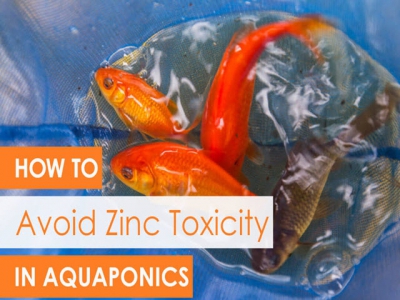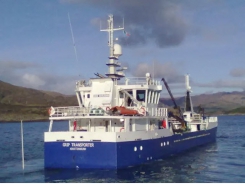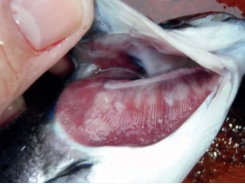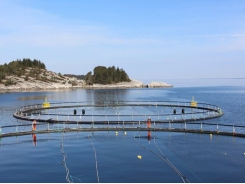How to Avoid Zinc Toxicity in Aquaponics

Galvanized steel in aquaponic systems
There are lots of reasons people use galvanized tanks in aquaponics systems. They are cheaper than stainless, they are durable, and they are readily available. Sounds great, right?
Galvanized steel can cause problems in aquaponic systems, however; if you are thinking about using one for your aquaponic system, it could save you some trouble down the road to know what you are getting into.
Galvanized = coated in zinc
Galvanizing is a process where the manufacturer dips the metal tank in a bath of molten zinc at a temperature of around 840 °F (449 °C). This is usually to prevent corrosion over time and to provide a cheaper alternative to stainless steel.
What’s wrong with a little zinc?
Zinc is a common micronutrient for plants. This leads some people to think it is safe for aquaponics systems. While it is true that plants can tolerate pretty high zinc levels in solution, fish cannot.

Water quality guidelines can be found online if you know where to look. We often recommend technical information from ATTRA or the Purdue Agricultural Extension. Purdue recommends levels of zinc be kept between .03 and .05 ppm. Most fish will become stressed at .1 to 1 ppm, and will start dying off at 4-8 ppm.
According to the American Galvanizers Association: “The biggest factors in the zinc corrosion rate in fresh water are dissolved gasses, hardness/mineral rate, flow rate, and other ions/chlorides, the hardness of the water and the pH levels.” These factors make it hard to predict exactly how much zinc will be released from your tank.
The aquaponic community has a number of discussions related to this topic. Big thanks to Jimmy Ward, of the Backyard Aquaponic community, who shared a detailed description of his struggle with galvanized steel tanks.
Can I just paint the tank with plastic polymer?
You may have seen examples of someone painting their galvanized tank with a heavyweight epoxy, or a fish safe polymer of some sort (eg. Pond Armor). This has proven successful in some situations and can be considered if it is too late to choose a different tank.
The danger in this option is that new tanks may have an oily layer left over from the manufacturing process, which makes it difficult for the paint to adhere to the surface of the galvanized. Over time, your system may flake or otherwise allow more zinc into the water. If you have an old tank laying around, you may be able to avoid this problem, although using old tanks can lead to other types of problems.
We have seen enough mishaps in the aquaponic system startup phase to recommend avoiding this solution. Instead, we recommend finding an alternative to galvanized steel tanks.
What are my options?
Here are some options:
- Use a tank liner
- Build your own tank
- Roto-molded
- IBC tanks

1) Use a tank liner
If you already have a galvanized tank, and you won’t be investing in a new tank, you might choose to line the tank with something. Heavy duty pond liner can be used, although it is a little pricey. Also, to get a good fit you will need to cut and join the seams using a sealant (WARNING! Intense elevator music in this tutorial).
2) Build your own
If you are handy, you can build your own tank out of plywood using sealants and/or a pond liner. You can get creative with materials and with designs. John Kohler, of Growing Your Greens, gives us a walkthrough on a sweet DIY fish tank on his Youtube channel. This tank was built using just 2×4 lumber and a special seamless coating. Tune in at minute 15:30 to get right to the DIY goodness.
There may be a size limit to how big you can build using your own materials. You may choose a long, trough-like design to help keep things manageable. The difficulty is to build a large enough tank while eliminating leaks and weak points.
3) Roto Molded Fabrication
Most regions will have at least one or two roto molding (rotational molding) companies nearby. Common products will include septic or holding tanks. Many companies offer specific products for agriculture, although as long as the materials are neutral they will be fine for fish cultivation. Here is a 2,150-gallon tank for around $1,400. Shipping on this unit was calculated around $400, although many tanks require a custom shipping quote.

Caution! Shipping for large tanks can be expensive. Make sure you have a shipping quote locked in before you buy.
4) IBC Tanks
IBC tanks can be a solution for smaller or medium systems. We talk with dozens of growers who have found second hand IBC tanks for under $100. In Denver, you can find hundreds of used tanks available on Craigslist (check out these examples here). Many sellers will be selling both food grade and non-food-grade IBC tanks. Make sure you ask what was in them. Some sellers pre-rinse their tanks, which can save you some labor.
If you can’t find a used one, you can buy new from Uline. Prices run around $499 for the 275-gallon tank or $529 for the 330-gallon tank.
Conclusion
Using galvanized steel tanks can be a major reason that beginning aquaponic growers lose so many fish when they’re starting their systems. This can lead to confusion over the cause of the die-off, as many a seasoned aquaponic grower knows. If it is not too late, we recommend avoiding galvanized steel tanks altogether.
We hope that this article helps you to avoid mistakes in your aquaponics system.
Related news
Tools

Phối trộn thức ăn chăn nuôi

Pha dung dịch thủy canh

Định mức cho tôm ăn

Phối trộn phân bón NPK

Xác định tỷ lệ tôm sống

Chuyển đổi đơn vị phân bón

Xác định công suất sục khí

Chuyển đổi đơn vị tôm

Tính diện tích nhà kính

Tính thể tích ao




 Diseased salmon debate heats up
Diseased salmon debate heats up  Dutch investment fund backs IoT based feed efficiency…
Dutch investment fund backs IoT based feed efficiency…